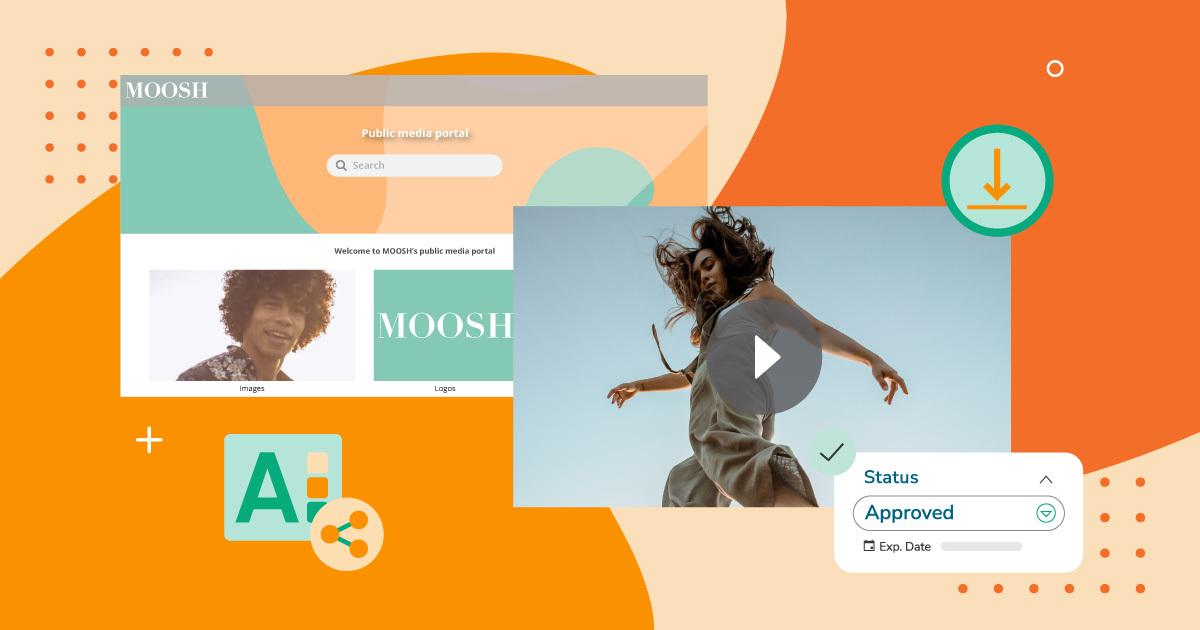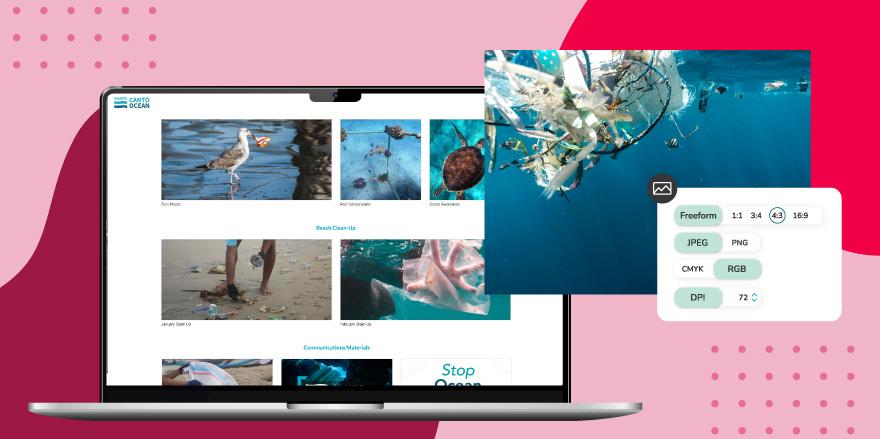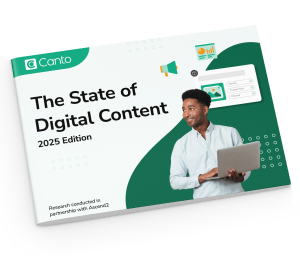Why brand portals aren’t convenient — they’re essential
| May 27, 2025

Managing brand assets across multiple departments, partners, and platforms can quickly become chaotic. Without a centralized system, it’s easy for teams to waste time searching for the right logo, sending outdated content, or responding to endless email requests. That’s where a brand portal comes in.
Whether you’re running a large marketing team, collaborating with external partners, or supporting sales across regions, a brand portal simplifies how you organize, share, and protect your digital assets. It acts as your branded command center — a secure, easy-to-use space for everything related to your company.
In this guide, we’ll explore what a brand portal is, how it works, and how your business can benefit from using one. We’ll also walk through how portals support both internal workflows and external collaboration, especially when built into a larger digital content brands strategy using a platform like Canto.
What is a brand portal?
A brand portal (also referred to as a branding portal or brand management portal) is a flexible work area within a digital asset management (DAM) platform that gives users access to your organization’s digital content. It’s a window into your digital content where users can securely browse, search, and download approved brand materials.
This could include:
- Logos and icons
- Product images and videos
- Brand guidelines
- Brochures and sales decks
- Social media templates
- Press kits
To illustrate: imagine a journalist writing about your company. Without a portal, they’d have to email someone on your team, the team member would need to take time from their day to fulfill the request, and meanwhile, the journalist is waiting for the right assets. But with a branded client portal, they can find exactly what they need, on their own, anytime. It’s self-service, secure, and saves everyone time.
4 reasons to use a brand portal
1. Faster, smarter sharing with external users
If your marketing or PR team regularly fields requests for assets, a brand portal can dramatically cut down on back-and-forth communication.
Instead of emailing files or granting access to cloud folders, you can direct external users — like journalists, partners, or freelancers — to your partner portal where they can find and download assets themselves.
Branded content hubs:
- Speed up delivery of digital content
- Reduce repetitive requests to your team
- Ensure people always get the most up-to-date versions
Whether you’re distributing content to media outlets or enabling partners in a B2B branded ecommerce portal, a centralized portal builds efficiency and trust.
2. Simplify internal brand operations
Internally, different teams have different needs. Your HR department might need branded letterheads and employee handbook templates. Sales might need the latest product one-pagers and testimonials. But not everyone needs access to everything.
A branding portal allows you to control who sees what, so teams only access the content relevant to their roles. This eliminates confusion, keeps your library organized, and reduces the risk of off-brand materials being used.
Even better, most brand management portals include admin controls so you can:
- Set permissions by department or user role
- See who’s downloaded what and when
- Keep older versions archived but accessible
3. Maintain brand consistency everywhere
Brand consistency isn’t just a nice-to-have — it directly impacts how customers perceive your business. But consistency is hard to maintain when brand materials are scattered across platforms or passed around via email.
A portal for brand assets ensures that everyone is using approved, up-to-date visuals and messaging. It also prevents multiple versions of assets from circulating — a common issue for growing brands.
For companies with distributed marketing teams, global offices, or multiple external vendors, having a brand content hub is essential. It keeps everything aligned and reinforces a unified, polished brand presence across all touchpoints.
4. Secure, trackable access
Brand portals offer another major benefit over traditional file sharing — control.
With a brand management portal, you can:
- Monitor downloads and usage
- Set expiration dates for sensitive content
- Add password protection or single sign-on (SSO)
- Enable access restrictions
This level of visibility helps your brand stay protected, especially when you’re dealing with embargoed assets, licensed photography, or campaign materials not meant for general distribution.

Brand portal use cases
A brand portal can be used for many different needs, whether you’re working with global teams, external partners, or e-commerce distributors. Let’s take a closer look at some real-world brand portal use cases and how each one serves a specific purpose within a larger brand strategy.
Partner portal
A partner portal is designed for external business partners, like agencies and affiliate marketers, who need easy access to branded materials. By centralizing logos, product specs, banners, and promotional content, you reduce friction in your partnership and ensure that brand integrity is maintained across channels.
It’s also useful for onboarding new partners. Rather than sending out a series of onboarding emails or scattered files, everything they need is housed in one secure, branded location.
Brand asset portal
This use case focuses on providing internal and external users with access to your official brand assets—logos, typefaces, color codes, iconography, and more. A brand asset portal acts as a style guide in action. Instead of emailing PDFs or hunting through folders, users can view and download assets directly from the portal, knowing they’re always using the latest versions.
Brand content hub
A brand content hub is broader than an asset library. It includes everything from blog content and social media visuals to video libraries, campaign kits, and messaging guidelines. It’s particularly helpful for global organizations with many content creators who need access to editorial materials and branded multimedia in one place.
Branded client portal
For agencies, freelancers, or service-based businesses, a branded client portal gives clients direct access to project files, reports, deliverables, and resources — all within a branded environment that reflects your business identity.
It not only looks professional but also improves client satisfaction by making it easier to find and retrieve important content. Clients won’t need to dig through email threads or ask for access — they’ll know exactly where to go.
B2B branded e-commerce portal
A B2B branded e-commerce portal is perfect for companies that supply distributors or retail partners. In addition to product catalogs and order forms, these portals offer brand-approved marketing materials like packaging mockups, signage, and sales tools.
To ensure product data is as consistent as your brand visuals, product companies tend use a product information management (PIM) system together with DAM solutions. Tools like Canto PIM make it easier to centralize and distribute accurate, up-to-date product information straight to retail channels — everything from SKUs and descriptions to specs and images.
By combining PIM systems with brand asset access, you streamline both the marketing and sales process for your products, while maintaining a cohesive customer experience.
Who should use a brand portal?
You don’t have to be a massive enterprise to benefit from a portal. Businesses of all sizes — from startups to global brands — use brand portals to improve content sharing, collaboration, and consistency.
If your team:
- Manages digital content across channels
- Works with outside partners or media
- Struggles to keep track of asset versions
- Needs a better way to manage brand guidelines
…a brand portal can help!
Teams in marketing, sales, creative, HR, and communications all benefit from having a centralized, user-friendly system for accessing and distributing content.
Choosing the right brand portal
If you’re ready to implement a brand portal, look for a solution that fits your current needs but can scale with your business. Leading DAM platforms like Canto tend to offer the most robust brand portal options, along with custom branding, access controls, and integration with your existing tools.
Some features to prioritize:
- Easy user interface
- Customizable access permissions
- Branded interface and custom domain
- Analytics and reporting
- Support for large media files
- Integration with creative suites (e.g., Adobe, Canva)
Unlimited portals. Unlimited benefits — only with Canto
A brand portal isn’t just a convenience — it’s a strategic advantage. Canto DAM makes it easy to create and manage unlimited brand portals — no extra cost, no limits. As a leading DAM and PIM platform, Canto gives brands the power to organize, manage, search, and share their assets efficiently and securely. Want to learn more about how your brand could benefit? Download the guide below.

